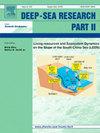Growth rates and ages of the small bamboo coral Acanella arbuscula in the Northwest Atlantic
IF 3
3区 地球科学
Q2 OCEANOGRAPHY
Deep-sea Research Part Ii-topical Studies in Oceanography
Pub Date : 2025-05-02
DOI:10.1016/j.dsr2.2025.105485
引用次数: 0
Abstract
Acanella arbuscula is a common deep-water bamboo coral in the Northwest Atlantic and is considered a Vulnerable Marine Ecosystems indicator. Growth rates and ages of A. arbuscula have not been confirmed, despite the importance of these metrics to understand the species recovery potential when disturbed. One-hundred and fifteen A. arbuscula samples were analyzed to examine the relationship between age, location, and depth, and how environmental conditions influence growth rates. Colonies were collected during scientific trawl or remotely operated vehicle surveys from the SW Grand Banks, Northern Labrador shelf, and SE Baffin shelf from depths of 178–1354 m. Skeletons were cross-sectioned at the proteinaceous nodes and examined under reflected light and fluorescence microscopy to quantify growth rings and determine age and growth rates. The species exhibited both major and minor growth rings. Major growth rings were confirmed to represent annual growth by comparing size metrics and age from a previously bomb-14C dated specimen of A. arbuscula versus specimens aged by growth rings. Minor (sub-annual) growth rings were not consistently observed across specimens and the cause of their formation is unknown. Ages ranged from 8 to 29 years, with radial growth rates of 0.025–0.160 mm/year and axial growth rates of 1.87–16.1 mm/year. Longevity for A. arbuscula is lower than the bamboo coral Keratoisis grayi in the NW Atlantic, but growth rates were consistent with other documented bamboo corals. Multiple regressions revealed that age influenced radial and axial growth rates, with no significant influence of bottom temperature or chlorophyll-a observed for radial growth rates. This study confirms frequency of ring formation in A. arbuscula and that growth rates for the species do not vary significantly based on geographic or bathymetric location.
西北大西洋小竹珊瑚Acanella arbuscula的生长速率和年龄
阿卡ella arbuscula是西北大西洋常见的深水竹珊瑚,被认为是脆弱海洋生态系统的指标。尽管这些指标对于了解受干扰时物种的恢复潜力具有重要意义,但其生长速率和年龄尚未得到证实。研究人员分析了150个A. arbuscula样本,以研究年龄、位置和深度之间的关系,以及环境条件如何影响生长速度。通过科学拖网或远程操作的车辆调查,从西南大浅滩,北拉布拉多大陆架和东南巴芬大陆架的深度178-1354米收集了殖民地。在蛋白质节点处对骨骼进行横切,并在反射光和荧光显微镜下进行检查,以量化生长环,确定年龄和生长速度。该物种的生长年轮有大年轮和小年轮。通过比较先前用14c测定的a . arbuscula标本与用年轮测定的标本的大小指标和年龄,证实了主要的生长环代表了年生长。在不同的标本中观察到的小年轮并不一致,其形成的原因尚不清楚。年龄8 ~ 29岁,径向生长率为0.025 ~ 0.160 mm/年,轴向生长率为1.87 ~ 16.1 mm/年。竹珊瑚的寿命低于西北大西洋的灰色角化珊瑚(Keratoisis grayi),但生长速度与其他竹珊瑚一致。多元回归表明,年龄对径向和轴向生长速率有影响,而底部温度和叶绿素a对径向生长速率无显著影响。本研究证实了A. arbuscula的环形形成频率,并且该物种的生长速率不会因地理位置或水深位置而发生显着变化。
本文章由计算机程序翻译,如有差异,请以英文原文为准。
求助全文
约1分钟内获得全文
求助全文
来源期刊
CiteScore
6.40
自引率
16.70%
发文量
115
审稿时长
3 months
期刊介绍:
Deep-Sea Research Part II: Topical Studies in Oceanography publishes topical issues from the many international and interdisciplinary projects which are undertaken in oceanography. Besides these special issues from projects, the journal publishes collections of papers presented at conferences. The special issues regularly have electronic annexes of non-text material (numerical data, images, images, video, etc.) which are published with the special issues in ScienceDirect. Deep-Sea Research Part II was split off as a separate journal devoted to topical issues in 1993. Its companion journal Deep-Sea Research Part I: Oceanographic Research Papers, publishes the regular research papers in this area.

 求助内容:
求助内容: 应助结果提醒方式:
应助结果提醒方式:


